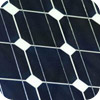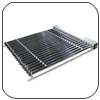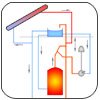Solar Water Heaters & Photovoltaic Cells
Introduction
Energy from the sun is gathered using panels, or ‘modules’, which can be added together to deliver sufficient energy for a household, depending on the size, location and orientation of the property.

Essentially there are two distinct types of solar panel; those that create electricity which can be used for lighting, heating or general power, or ‘photovoltaic cells’ and those that directly heat water, or ‘solar water heating panels’.
Pros & cons overview
Photovoltaic cells

- Receive larger government grants to aid installation
- Overproduction may be sold back to mains electricity supplier
- Require only daylight, not direct sunlight, to function
- Can cut average household electricity bill by about 30%

- Require a large roof area for decent output
- More expensive to install
Solar Water Heating Panels

- Require only 2-5m² roof space
- Can cut average household gas bill by about 15%
- Cheaper to install

- Receive smaller government grants to aid installation
- Cannot be used to heat water for central heating
- Require most combination boilers to be modified
- Requires space to install a hot water cylinder (or replace existing)
Photovoltaic (PV) cells

Photovoltaic cells are most commonly found on calculators that require no batteries to function. These panels are filled with semiconductor materials such as silicon, which absorb energy from the sun. This energy displaces electrons in the silicon which can then flow freely to generate an electric current.
- In fact, PV cells work better in cooler conditions, and since they require daylight, rather than direct sunlight, they can actually become more efficient on cloudy days!
As they are often cheaper to manufacture, you will also find photovoltaic cells that contain polycrystalline silicon, amorphous silicon, gallium arsenide, copper indium diselenide and cadmium telluride, which tend to be less efficient than monocrystalline silicon.
- All electrical appliances in the UK are designed to work using alternating current (AC), but PV cells produce a direct current (DC). Therefore a device called an ‘inverter’ must be added to domestic solar panel output to convert the current into a useful form.
Most photovoltaic installations are designed to work in conjunction with a mains electricity supply. This means that when the PV cells’ output cannot meet the households’ demand, supply is supplemented from the mains.
Conversely, when the solar panels are generating more than enough electricity, the additional capacity can be funnelled back into the national grid, for which you can expect to be paid approximately 75% of the normal cost of a unit of electricity (kWh).
For properties that aren’t connected to a mains supply, it is advisable to include some kind of rechargeable battery in the system, so that when more electricity is being generated than is being used, the additional charge can be stored for later use. Choose nickel-cadmium deep-cycle batteries as these last longer and can be more completely discharged than alternatives. You will also need a ‘charge controller’ unit which extends the useful life of batteries by ensuring that they are not overcharged or completely drained. Batteries will require maintenance and will need to be replaced more frequently than the solar panels themselves.
Solar water heating

There are two types of solar water heating panels, both of which essentially heat water using the sun’s radiation. The panels are covered in glass which acts like a greenhouse, absorbing and intensifying the sun’s infra-red radiation to raise the temperature of the water that passes close by in micro-bore copper piping. Water in the panel can reach 80°C in the summer and 60°C in the winter.
- Flat plate solar panels have good efficiency and are the cheaper option.
- Evacuated tube solar panels look rather like an old fashioned radiator as they are subdivided into glass tubes each of which holds a copper pipe containing water, but these copper pipes are surrounded by a vacuum so that as little of the sun’s energy is lost. Evacuated tubes are more efficient, even working at low temperatures, they require a smaller area to function adequately, but they are more expensive.

Once the water has been heated in the panel, it is pumped to a heat exchanging coil where the heat is passed from the water that flows through the solar panel to the water that flows through your domestic plumbing to be stored in an insulated cylinder.
- The heated water can then be made available to taps, showers, a washing machine and even a swimming pool.
Particularly in the UK, when winter sun cannot deliver water at a high enough temperature, the solar panels should be used in conjunction with a normal heating system such as a boiler or immersion heater to provide backup heating and hot water.
- Most combination boilers do not accept pre-heated water.
Instead they will need to be modified to turn off the instantaneous water heating function and thus use them as a conventional boiler instead. This means they will be heating water for storage in a cylinder as part of an unvented system.
Most solar panel installation companies should be able to make these modifications for you.
Solar water heating units usually also have a small area of photovoltaic cells which generate the electricity that runs the pumps and control units of the water heating unit. Solar water heating is therefore a completely self-sufficient system.
To prevent the water from freezing during the winter, the water that is pumped through the solar panel often has anti-freeze added to it, or a system that withdraws the water when it is too cold, and even too hot, can be used to achieve the same end.
Further information and useful links
- Accredited installers of solar panels (lowcarbonbuildings.org.uk)
Site Pages
Featured Articles





